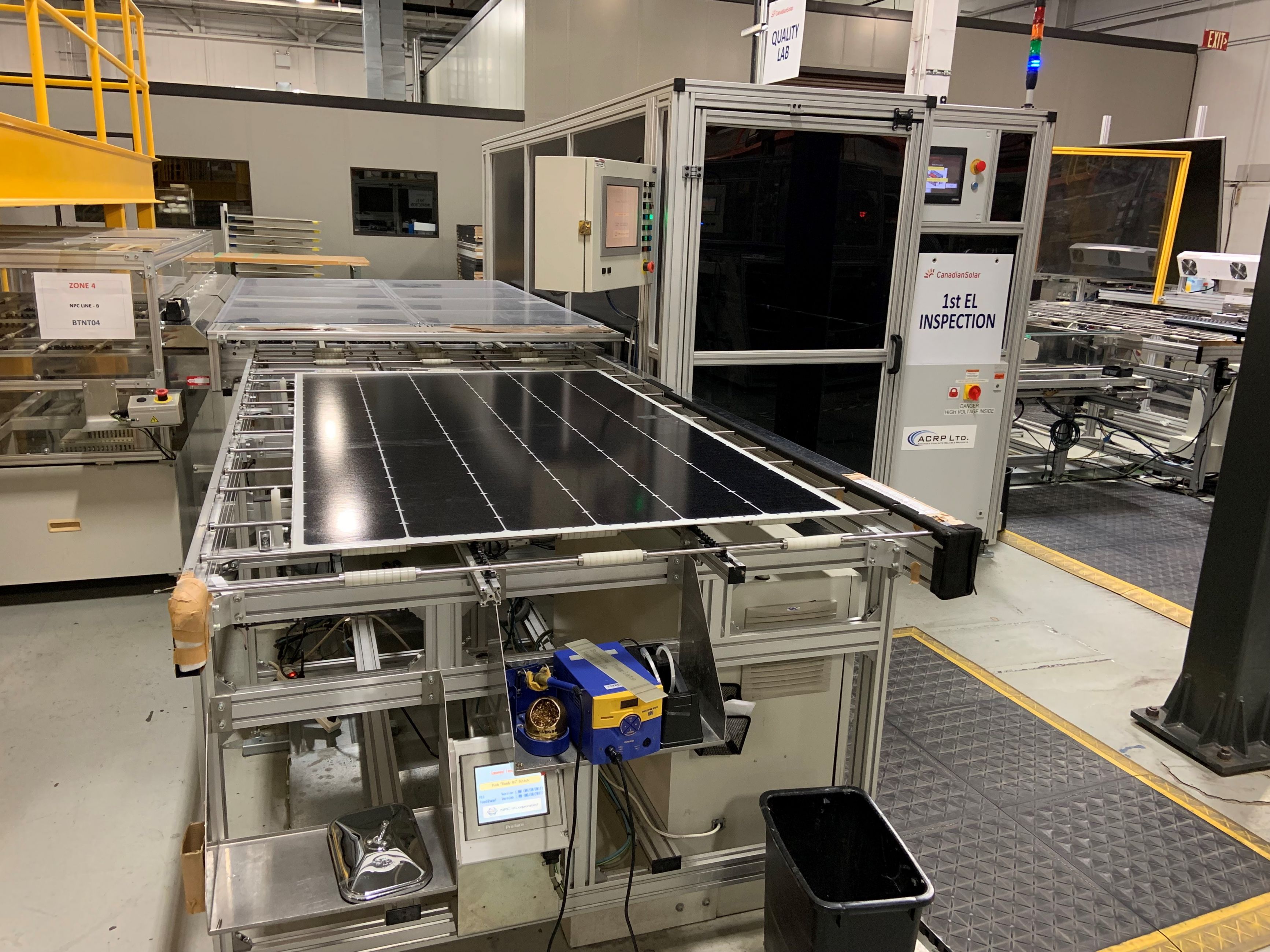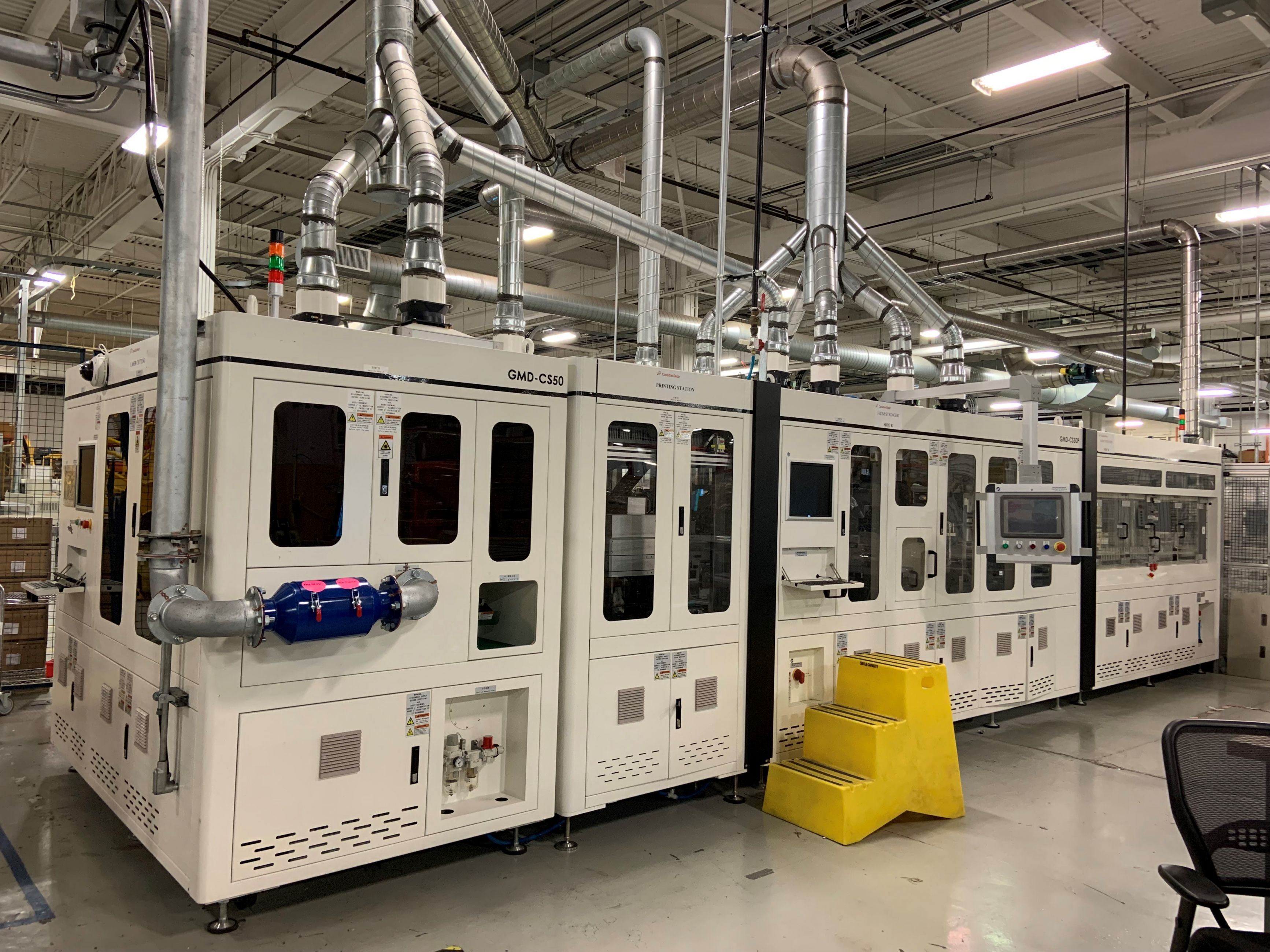High Density Solar Photovoltaic Module
Lead Proponent: Canadian Solar Solutions Inc.
Location: Guelph, ON
CEI Contribution: $ 7,950,000
Project Total: $ 16,003,501
Strategic Area: Renewable Energy, Smart Grids, and Storage
Status: Completed
Project Background

Rework station at Guelph facility
The rework station is used for a module that has any defects that are found by an Electroluminescence tester. The operator manually fixes these defects on this station.

Stringer machine at Guelph facility
A stringer machine whose main functions are cutting a full cell into 6 small cells, printing ECA on each small cells, separating the 6 small cells, then placing them together by the robot for soldering.
Canadian Solar’s High-Density Module (HiDM) project’s overall objective was to deliver an innovative technology to the domestic and global marketplace. This project set out to build a new solar module with higher density cell technology, which allowed a full cell to be split into 6 smaller cells through laser technology and generated higher efficiency modules with less defects overall. The project was awarded $7.95M from Energy Innovation Program.
The HIDM technology has the highest efficiency rating in its class, a key differentiator in the marketplace – and one that allows for Canadian Solar to address many issues in the current solar panel marketplace. This new innovative manufacturing process allows for savings in land/rooftop space, installation, and maintenance.
Lastly, this new HIDM technology is ideally suited to satisfy Canada’s policy objectives for developing systems in remote communities to decrease diesel use and increase capacity building, as well as for federal buildings as part of the country’s 100% Greening the Government Initiative. Having domestic manufacturing allows for sourcing of local goods providing ancillary economic benefits to Canada.
Results
Over the course of this project, Canadian Solar demonstrated improvements to photovoltaic (PV) cell performance and reliability through an innovative manufacturing method. In this manufacturing process, strips of individual solar cells were shingled and joined together using an electrically conductive adhesive (ECA). This shingling process resulted in higher panel output & efficiency. The individual cells are then able to absorb more solar energy, thus allowing the final modules to generate more electricity for end users.
These efficiency gains were realized through a complete redesign of production line B in the Guelph, ON manufacturing facility. The space was reconstructed, reducing bottlenecks in production – and key machinery was replaced to allow for higher daily outputs. In the final year of the project (2020-2021) – the average daily output was 249 modules per day, which equates to roughly 10.42MW of solar capacity produced per year.
Canadian Solar was also able to improve upon the design through a new ECA. The previous ECA was a mixture of copper and silver, however, once a new 100% silver ECA was introduced – the cells had lower volume resistance and put out an overage of 1W more per panel. This advancement in ECA research and development led to one of seven patents that were filed and received over the course of the project.
Benefits to Canada
This project demonstrated the capacity for Canada to design and manufacture new technology within the solar energy industry. It highlighted a competitive advantage for Canadian manufacturing and ultimately succeeded in creating a highly efficient solar module that outperforms similar solar PV technology. Over the course of the project, 35 manufacturing jobs were created in Guelph, ON. Furthermore, 10.42MW of solar modules were sold in the final year of the project, resulting in an increase in renewable energy penetration and GHG savings (through displacement of fossil-fuel generation sources).
Next Steps
In the following months and years, Canadian Solar is considering the introduction of an all-black module with the HIDM technology, which incorporates a black cell, black frame, and black back sheet. This new module will become highly sought after in North American due to the pleasing aesthetics it offers to homeowners and businesses alike. These new all-black panels aim to tackle the residential and single-family dwelling market – as the overall look of the panels is very similar to a traditional asphalt shingle. Moreover, the coming product makes more economic sense as the size will be increased, yielding a higher output and efficiency rating, while maintaining the same low manufacturing costs.
Find out more:
Public Report: https://youtu.be/RsbL_hmlVFQ
Page details
- Date modified: